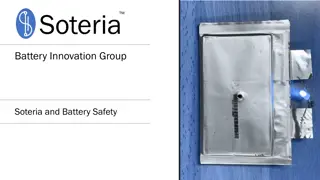Lithium Battery Safety Course Overview
This course aims to educate workers and community members on the potential hazards associated with lithium batteries, safe handling practices, and emergency procedures. Covering topics such as identifying devices that use lithium batteries, understanding risks, implementing safe practices, and outlining emergency response actions, this course provides essential knowledge for ensuring safety when dealing with lithium batteries.
Download Presentation

Please find below an Image/Link to download the presentation.
The content on the website is provided AS IS for your information and personal use only. It may not be sold, licensed, or shared on other websites without obtaining consent from the author.If you encounter any issues during the download, it is possible that the publisher has removed the file from their server.
You are allowed to download the files provided on this website for personal or commercial use, subject to the condition that they are used lawfully. All files are the property of their respective owners.
The content on the website is provided AS IS for your information and personal use only. It may not be sold, licensed, or shared on other websites without obtaining consent from the author.
E N D
Presentation Transcript
Lithium Battery Safety Course Goal This course trains workers and community members regarding the potential hazards of lithium batteries, safe handling practices, and what to do in case of emergency. 1
Acknowledgement The Midwest Consortium for Hazardous Waste Worker Training created this program under cooperative agreement number U45 ES 06184 from the National Institute of Environmental Health Sciences (NIEHS). 2
Course Objectives After completing this course, you will better be able to: 1. Identify devices that use lithium batteries 2. Describe potential risks of lithium batteries 3. Identify safe practices for lithium batteries, including use, charging, storage, and disposal 4. Identify action steps in case of a lithium battery emergency 3
Agenda 1. Types and Uses of Lithium Batteries 2. Potential Hazards 3. Usage 4. Charging 5. Storage 6. Disposal 7. Emergency Actions 8. Exercises 4
1. Types and Uses Lithium batteries Are commonly used in many workplace and consumer products Store a large amount of energy in a very small space Are safe when handled correctly and are free from damage or defect 5
Lithium batteries in the news Recent fires E-scooter - Manhattan apartment fire Electric wheelchair - Detroit apartment fire 6
1. Types and Uses Lithium-metal batteries are usually not rechargeable and are found in watches, car key fobs, and remote controls They are usually shaped like a button 7
1. Types and Uses: Designs Lithium-ion batteries are usually rechargeable and are used in devices such as cell phones, laptops, and cordless tools Their shape can be: Prismatic Pouch Cylindrical 8
1. Types and Uses How are lithium-ion batteries used? 9
2. Potential Hazards Lithium-ion batteries are a potential hazard when damaged. How are batteries damaged? Physical damage dropping, crushing, puncturing Temperature extremes flames, heaters, freezing Improper charging 12
2. Potential Hazards Lithium-ion batteries are a potential hazard if defective. Like any other product, a small number of batteries are defective. Signs of a defective battery are odor, change in color, giving off too much heat, change in shape, leaking, smoking, hissing. Purchase devices and batteries from a reputable source, ideally with an appropriate test standard (e.g., UL 2054). 13
2. Potential Hazards Fire very hot, sustained, thermal runaway, may produce toxic gas Explosion Damaged or defective batteries can catch fire even when not being charged or in a device Video showing what can happen when a lithium battery is punctured - Lithium battery fire 14
3. Usage No federal standards (for example, OSHA) exist for lithium battery usage Follow manufacturer instructions for using devices and batteries Put batteries in device correctly Use correct batteries with devices; do not use a battery in a way for which it is not intended Keep batteries at room temperature; do not place batteries in direct sunlight, on hot surfaces, or keep them in hot vehicles Inspect batteries regularly for damage 15
4. Charging Fire can start during charging e-bikes and e-scooters in news recently Follow manufacturer instructions for charging Charge batteries with the correct charger Do not overcharge; remove batteries from charger when fully charged Do not charge a device under your pillow, on your bed or on a couch Never charge disposable batteries Charge and store batteries in a fire-retardant container if possible Do not parallel charge batteries of varying age and charge status Allow time for cooling before charging a battery that is still warm from usage and using a battery that is still warm from charging 16
4. Charging Electric Vehicles Follow manufacturer guidelines when charging your vehicle. Use a charging device that is certified by a nationally recognized testing laboratory. Plug Level I EV chargers directly into an outlet designed to handle the amperage of the charging device. Never use a multiplug adapter or extension cord. Install a ground-fault circuit interrupter (GFCI) with the charging unit. It will turn off the power if a fault is detected and help prevent a fire. Place all charging device components out of reach of children when not in use. Maintain the components of your charging station according to the manufacturer s maintenance guidelines. Signs of excessive wear may indicate a potential shock hazard. Never use an EV charger with obvious signs of damage. Cover the EV charging station outlet to stop water from entering. Check the manufacturer s guidelines to make sure it is safe to charge your EV in wet conditions. 17
5. Storage Store batteries away from anything that can catch fire Store batteries and devices in dry locations at room temperature Remove batteries from the device for long-term storage Keep charged and depleted batteries separate (or keep a log) If practical, store batteries in a metal storage cabinet Visually inspect battery storage areas at least weekly Charge batteries in storage to approximately 50% of capacity at least once every six months to preserve battery life 18
5. Storage - Airplanes Spare lithium batteries and battery chargers must be carried in carry-on baggage only. Devices with lithium batteries such as laptops should be carried in carry-on baggage when possible. If in checked baggage, they should be powered off and protected from damage. 19
6. Disposal Do not put lithium batteries or devices containing lithium batteries in the trash or recycling bins - they could become damaged during processing and start a fire Take them to a battery recycling location (Find battery recycle center) or follow your workplace protocol Follow manufacturer information for disposal of damaged batteries Tape battery terminals and/or place each battery in a separate plastic bag; do not make piles of discarded batteries 20
6. Disposal for Businesses Most used lithium-ion batteries meet the definition of hazardous waste under the Resource Conservation and Recovery Act (RCRA) Non-household waste generators will likely need to manage disposal under federal universal waste regulations in 40 CFR Part 273: 40 CFR Part 273 This may include requirements for employee training, labeling containers, length of time stored prior to disposal, and shipping 21
7. Emergency Actions If you notice an odor, change in color, giving off too much heat, change in shape, leaking, hissing . Stop using the battery If you can do so safely Disconnect the battery and/or remove it from the device Move battery away from other flammable items Store battery in sand, dirt or kitty litter 22
7. Emergency Actions: Fires Call 911 if you need assistance Follow manufacturer s guidance on how to extinguish small battery fires, which could include using: Class ABC dry chemical extinguisher Class BC CO2 fire extinguisher Sand, dirt, or kitty litter 23
7. Emergency Actions: Emergency Response Guidebook The US Department of Transportation Emergency Response Guidebook offers guidance on lithium-ion battery emergencies. 24
Resources OSHA - https://www.osha.gov/sites/default/files/publications/shib011819.pdf NFPA - https://www.nfpa.org/-/media/Files/Public-Education/Resources/Safety-tip- sheets/LithiumIonBatterySafety.ashx FAA - https://www.faa.gov/hazmat/packsafe/ EPA - https://www.epa.gov/recycle/used-lithium-ion-batteries FEMA - https://www.usfa.fema.gov/downloads/pdf/publications/electric-vehicle-safety-handout.pdf University of Washington - https://www.ehs.washington.edu/system/files/resources/lithium-battery- safety.pdf 26
Summary Lithium batteries are widely used at work and home Damaged or defective lithium batteries are a fire and/or explosion risk Lithium batteries should be properly used, charged, stored, charged, and disposed of properly In case of lithium battery malfunction, try to remove the battery and move it away from flammable items 27
Exercise #1 In your small group discuss: Where do you use lithium batteries at work? At home? How can you more safely handle lithium batteries? Discuss usage, storage, charging, and disposal. Does your workplace have a standard operating procedure (SOP) for lithium batteries? If not, how would you go about developing one? 28
Exercise #2 In your small group discuss the following scenarios: Scenario 1: You ve accidentally punctured the battery on your cordless drill. What should you do? Scenario 2: You left your laptop on a heater, and you now notice smoke coming out of it. What should you do? Scenario 3: You are charging several lithium batteries when you notice they are on fire. What should you do? Scenario 4: You are in an accident involving several cars. One of them, a hybrid, is on fire. What should you do? 29
Exercise #3 In your small group, use the DOT ERG (Guide 147) for the following scenario. At your workplace, lithium-ion batteries are stored/re-charged along the wall in a large room. The room contains some machinery and various chemicals. Several people are typically at work in the room. You notice a small fire coming from the batteries. What should be your immediate action steps? What is the evacuation distance? What PPE should be worn? 30























